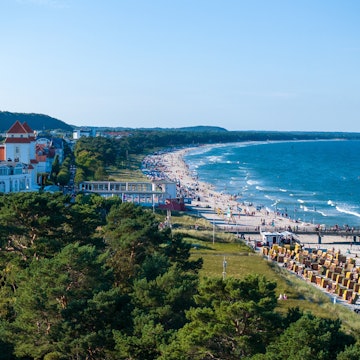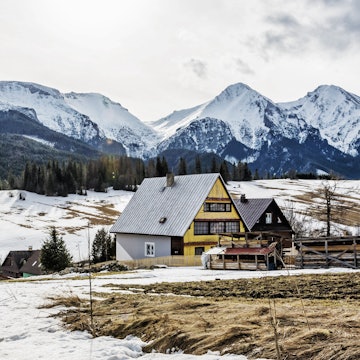
Warsaw vs Kraków: which Polish city will win your heart?


Don't worry if you can't choose between Warsaw and Kraków, our writers are here to help. Getty Images
When it comes to two Polish titans battling for first place, how can you possibly choose just one to spend your time in? Wonderful Warsaw and compelling Kraków both have incredible experiences to enjoy, excellent dining scenes, inspiring culture, historical significance and a thriving nightlife.
Relax, sit back and worry no more. Two esteemed Lonely Planet writers are here to pitch you the best that their beloved cities have to offer in an effort to win your heart. The only thing left for you to do is start planning that trip.
Forward-looking Warsaw never fails to inspire
Laura Studarus is a freelance writer who has visited Warsaw every summer for the last decade. Her idea of a good time is fueling up on pierogi from a milk bar, grabbing her camera, and spending the day walking across as much of the city as possible.
Warsaw is still Poland's wild child, constantly redefining its identity as it grows and leaves communism further in the rearview mirror. While Kraków is undeniably beautiful, it also feels stuck in time. Experiencing the modern side of Poland requires a visit to its capital city.
The capital city has a unique ability to repurpose the past. You can see the trendy pizza place, bakery, and jazz bar housed inside the Former Polish Communist Party HQ. There’s also Hotel Warszawa, a former WWII stronghold turned five-star accommodation. Or maybe you’d prefer to eat at Hala Gwardii, a former boxing hall turned food hall. The fine art of repurposing has led to comparisons with Berlin but like all travel dupes, the similarities are only a starting point.

You’ve probably seen photos of Warsaw’s colorful Old Town. The neighborhood is an interesting window into the past but keep in mind that at only 71 years old, it’s a historical recreation. But age (or the lack of) has no impact on the beauty of this fairytale-like enclave – particularly from the viewing platform next to the main square when the entire area is drenched in pink hues by the sunset.
Compliment the experience by visiting the Palace of Culture and Science to get a birds-eye view of the city. A “gift” from Stalin to the people of Warsaw, the monument located in the exact city center is now a creative and social hub featuring a movie theater, a lively bar, and a viewing platform, which gifts you the view of a crazy quilt of twisting streets, brutalist architecture, and modernist skyscrapers.
Though the city center has an impressive list of attractions, modern Polish life takes place outside the hub. Head south to visit Mokotów, a neighborhood full of green spaces like wild Arkadia Park or serene Morskie Oko. In recent years Żoliborz has also been gaining popularity, as more restaurants and shops move out of the city center. And don’t forget to cross the river to the Praga side of the city where creativity (and large murals) dominates. Walk down the yarn-covered Kawęczyńska street, peep communist-era signs at the Neon Muzeum, or explore Saska Kępa to explore the boutiques and restaurants, or just people watch in the shadow of the National Stadium.

The area around Vistula River isn’t so much a neighborhood but rather a seasonally specific delight. In winter, you’ll find an abandoned strip of icy riverbank but during the summer, the space comes alive with beaches at Poniatowski Bridge, Płyta Desantu, and Saska Kępa. Public drinking laws are relaxed and the traffic from pop-up river barge bars spills over onto the concrete steps. Visit the OG waterhole BarKa for their deep bench of Polish beer and regular concerts from local bands.
Food is a central part of Polish culture and some might say the best part of Warsaw. A decade ago, the most notable restaurants in the city would have reflected the most traditional cuisine. You can still enjoy traditional Polish pasta at Pyzy Flaki Gorace, which places their carb-blessed creations in jars, or modern twists on pierogi at Syrena Irena. Milk bars – low-cost cafeterias serving fresh food quickly – also dot the city, and honestly, you can’t go wrong at any of them. And, despite a tradition of meat eating, Warsaw is quickly rising as a vegetarian destination, with fine dining (Peaches), burgers (The Good Burger), and even bakeries (Eter) among their notable offerings.
Why not? For Warsaw, reinvention is key, making each visit more vibrant than the last.

Romantic Kraków will always have my heart
Anna Kaminski is a freelance travel writer who has traveled the world and delighted in reporting back on her experiences. She's been visiting Kraków since childhood and has no plans to stop anytime soon.
I first came to Kraków when I was fourteen years old, as part of a school history trip to Poland. I remember it vividly: seeing bison and having a snowball fight in Białowieża National Park; the desolate remnants of Nazi concentration camps; eating an obwarzanek (Cracovian bagel) in Kraków’s immense Market Square; snow glistening on the city's impressive castle; getting surreptitiously drunk with my friends for the first time in my life on vodka of questionable vintage; surreptitiously licking the wall of the underground salt cathedral at the Wieliczka Salt Mine to determine that it was indeed made of salt (it was!); the claustrophobic ride back up to the surface in a tiny miners’ lift…
Out of Poland’s two main urban centers, it was Kraków that beguiled me. It seemed like a proper city to me, overlooked by the impressive Wawel Castle, the attractive cobbled streets of its Old Town packed with Renaissance, Baroque and Gothic mansions, palaces and churches. By contrast, I found Warsaw unmemorable – it had no discernable center and consisted of haphazardly built, unpretty Soviet-style architecture. Of course, that wasn’t Warsaw’s fault. Our teachers explained it had been bombed extensively by the German Luftwaffe in WWII, while Kraków was spared, but I couldn’t understand why Warsaw became the postwar capital instead of its much more regal-looking sister that had been the seat of Poland’s kings and queens for many centuries.

As an adult, I’ve been drawn back to Kraków time and again. It’s so packed with diverse attractions that you can spend weeks exploring and not see everything on offer. Every interest is catered to here – delve into the fascinating workings of medieval Kraków’s sewer system at the fantastic interactive Rynek Underground; learn to create stained glass in the manner of Poland’s art nouveau maestros, Wyspiański and Matejko, at the Stained Glass Museum; behold abstraction pieces by Kandinsky and Malevich at the National Museum; check out Copernicus’ private rooms at the Collegium Maius, Poland’s oldest university; attend a cabaret performance at the Piwnica Pod Baranami cellar bar or groove along to klezmer as you eat at Klezmer-Hois; or take a trip down nostalgia lane by checking out vintage trams and 1950s motorbikes at the Museum of Municipal Engineering. Despite the fact I've been visiting for years, I've never run out of new wonders to discover.
There's nothing like wandering through neighborhood streets that are so vastly different from one another. Take in the grand boulevards and brutalist architecture of the 1950s socialist workers’ paradise of Nowa Huta, with its incredible Arka Pana church, the art nouveau mansions of the Piasek and Nowy Świat neighborhoods, and the offbeat attractions of Podgórze, from the ancient Krakus Mound to the overgrown, abandoned Liban Quarry – a former labor camp used in WWII.
The city is full of remnants of Poland’s vanished Jewish community: Schindler’s Factory, the Pharmacy Under the Eagle, Kazimierz’ cluster of synagogues (many turned into museums), and it’s usually the base for visiting Auschwitz, the most notorious of Nazi death camp. My Jewish ancestors had lived in Poland for centuries, so it’s all part of my family’s history, too, and I think that a visit to Auschwitz is essential to understanding how dark humanity can become.

On a lighter note, Kraków is full of surprises, and an unexpectedly wonderful summer destination. You wouldn’t necessarily think of it as a sun, sea and sand pick, yet they've turned the flooded, forest-fringed Zakrzówek Quarry into a beat-the-heat attraction, complete with five lifeguard-manned swimming pools, connected by floating wooden docks. Alternatively, I head for Bagry Lagoon or the Przystań Brzegi reservoir in eastern Kraków to swim, paddleboard or watch a game of volleyball, or take a bus out to Wolski Forest and go hiking in this vast protected woodland before coming back for pizza and beer at Kazimierz’s Weźże Krafta.
And don’t get me started on the food! Look, I’m an Eastern European, and Polish comfort food – pierogi (dumplings), kielbasa (Polish sausage), zurek (traditional sour rye soup) - gladden my gluttonous heart. In Kraków, I have my new favorite spots: Miła Bar Mleczny, an old-school 1980s-style canteen that harks back to life behind the Iron Curtain, where you can fill your boots with pierogi for a pittance; Goose Restaurant for fancier goose-filled dumplings; Unitarg Hala Targowa Sausage Stand for late-night sausages grilled over an open fire by two guys who’ve been doing it since 1991.
When I start to flag after that late night, I hit Somnium for great coffee and people-watching in Kazimierz, then bite into an epic maczanka (Cracovian pulled-pork sandwich) from the Andrus Food Truck at the Skwer Judah food truck park. See out the evening with some nouvelle Polish cuisine such as pearl barley kashotto with white asparagus at Pierwszy Stopień, and end a fun night with the best Thai street food outside of Bangkok at Molam Thai. Sorry, Warsaw: you just can’t compete with Kraków!













